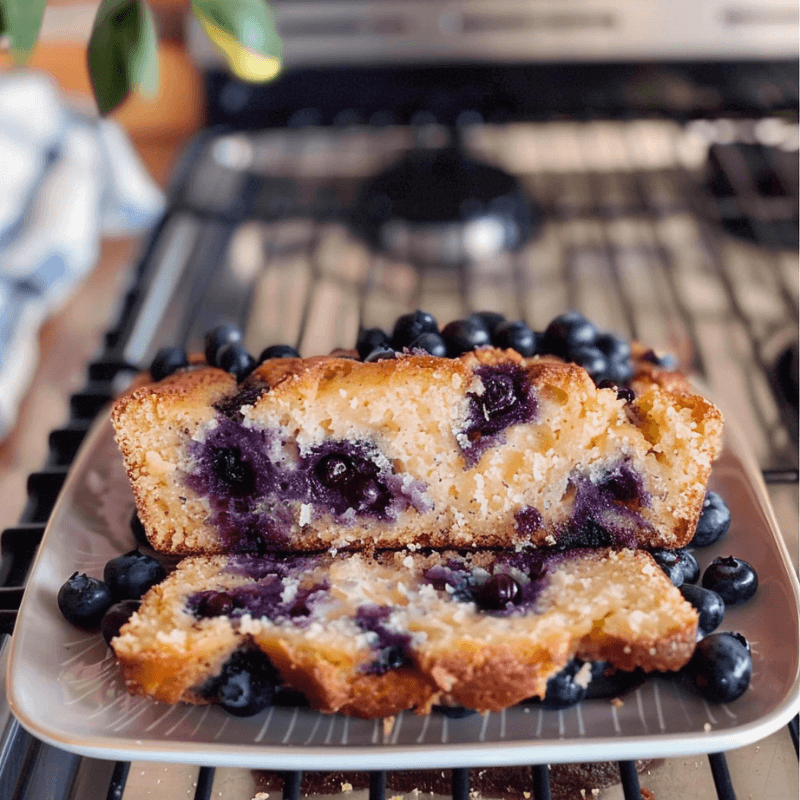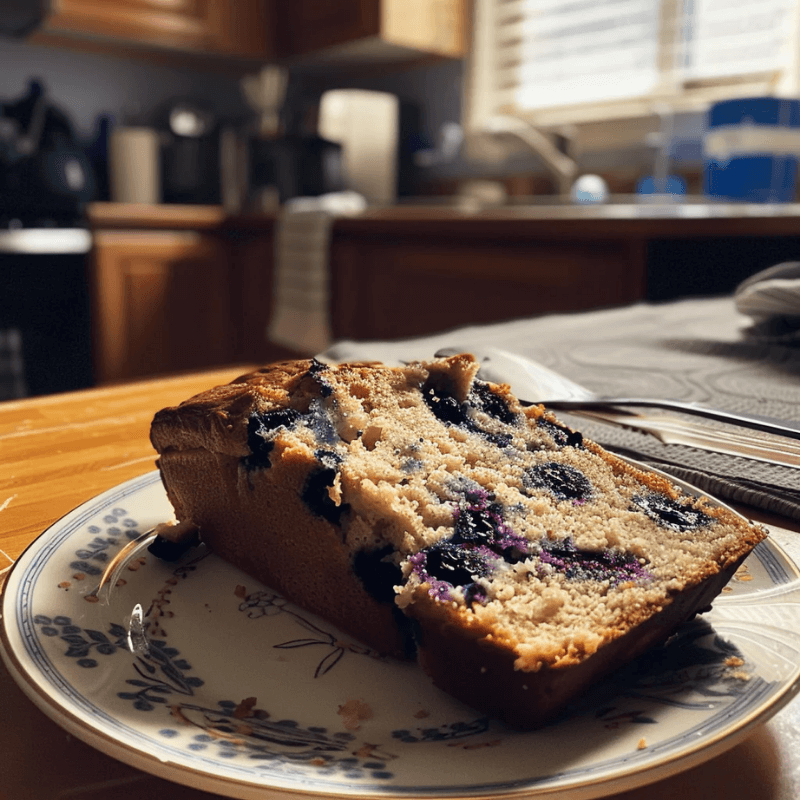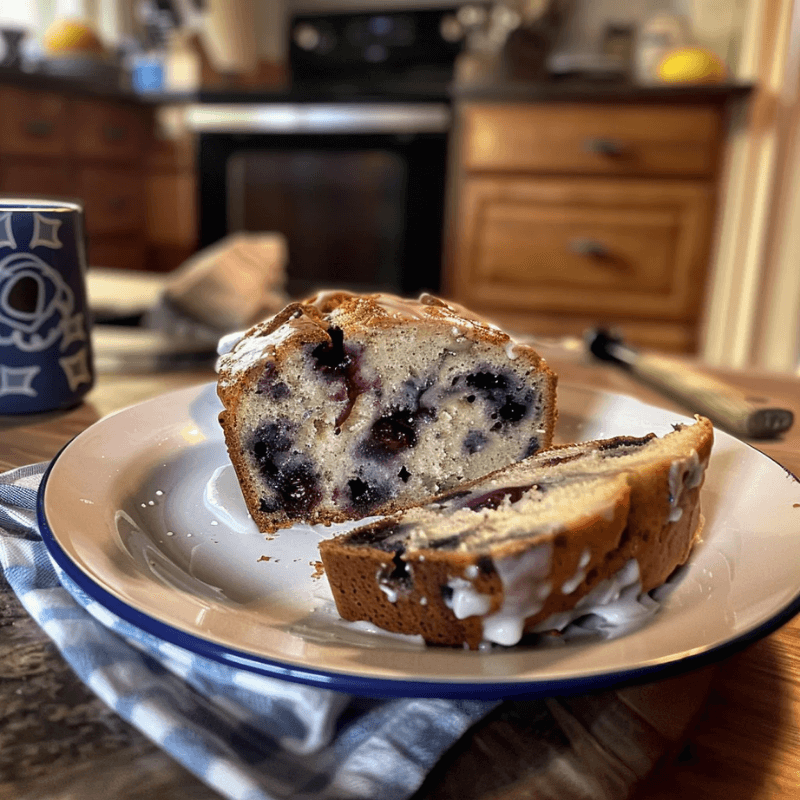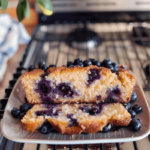Creating the perfect lemon blueberry bread takes just 15 minutes of prep time, yet the results are consistently moist, tender, and bursting with flavor. I’ve discovered that the secret lies in a combination of carefully selected ingredients and precise techniques.
Using fresh lemon zest, whole milk Greek yogurt, and the reverse creaming method, we’ve developed a foolproof recipe that produces an exceptionally moist loaf every time. The reverse creaming technique, which involves coating the flour with butter, prevents tough gluten formation and ensures a perfectly tender crumb.
In this tested recipe, I’ll share exactly how we achieved this deliciously moist texture that stays fresh for up to three days. Whether you’re serving it for breakfast, as a snack, or for dessert, you’ll learn the essential ingredients, mixing methods, and baking temperatures that make this bread consistently outstanding.
The Science Behind Super Moist Quick Breads
Understanding the science behind moisture in quick breads helps explain why some recipes succeed while others fail. The perfect lemon blueberry bread relies on specific scientific principles that govern moisture, texture, and overall quality.

Soft, moist, and bursting with blueberries – this Lemon Blueberry Bread is a must-try!
How moisture works in baking
In baking science, moisture is what gives quick breads their soft, pliable texture. Achieving the right moisture balance is crucial – too much creates gumminess, while too little results in that disappointing dry, crumbly texture we’ve all experienced.
The liquid ingredients play multiple essential roles. They moisten the batter, activate gluten in the flour, and dissolve sugar in the recipe. Additionally, proper moisture helps create that ideal “cotton-like” interior with even, small air cells rather than large tunnels or holes that indicate problems.
Quick breads naturally have high hydration levels – typically over 100% – which means more water than flour by weight. However, unlike yeast breads, this high hydration doesn’t negatively affect structure because eggs provide most of the structure in quick breads, not gluten development.
For lemon blueberry bread specifically, the blueberries themselves contribute significant moisture, adding natural sweetness alongside their juiciness. Nevertheless, their ripeness matters – overly ripe berries contain more liquid and can potentially throw off the bread’s structure.
Key factors that affect bread texture
The ideal ratio for most quick breads follows a simple formula: 1 part fat, 1 part egg/binder, 2 parts liquid, and 2 parts flour/dry ingredients. Straying from this ratio often leads to texture problems.
Mixing technique is arguably the most critical factor. The key to making tender, moist quick breads is proper mixing – not too much, not too little. Overmixing develops too much gluten, creating a tough, dense loaf. Undermixing results in insufficient rising. Using a gentle folding technique with a rubber spatula helps prevent overmixing.
Temperature considerations matter significantly. Room temperature eggs incorporate more air and blend more easily into batters. Cold eggs can lower the batter temperature, potentially causing underbaking in the center while the outside appears done – resulting in that frustrating sinking in the middle after cooling.
Gluten development needs careful balancing. Some gluten formation is necessary for structure, but excessive development creates toughness. Sugar helps maintain tenderness by inhibiting excessive gluten formation.
Fats like butter and oil are crucial for moisture retention and tenderness. They coat flour particles, limiting gluten development and creating that tender mouthfeel we crave in lemon blueberry bread.
Why most lemon blueberry breads turn out dry
Several common mistakes lead to dry, disappointing lemon blueberry bread:
- Flour measurement errors – Scooping flour directly from containers packs it into measuring cups, adding more than recipes require and creating denser, drier bread
- Overmixing the batter – This develops too much gluten, making the bread tough and less able to retain moisture
- Overbaking – Even a few extra minutes can significantly dry out your loaf
- Improper cooling – Wrapping bread before it’s completely cooled traps steam that rises to the surface, creating sogginess
Blueberries present unique challenges. Without proper preparation, they often sink to the bottom of the loaf and create moisture imbalance. Tossing them in flour before folding them into the batter helps them remain suspended throughout the bread during baking.
Furthermore, when the blueberries burst during baking, they release moisture unevenly. This can create pockets of sogginess alongside areas of dryness if not properly accounted for in the recipe.
By understanding these scientific principles, you’ll be better equipped to create perfectly moist lemon blueberry bread and troubleshoot issues when they arise.
Our Testing Process: Finding the Perfect Moisture Balance
After identifying the science behind quick bread moisture, I launched into extensive kitchen testing to discover exactly what makes lemon blueberry bread exceptionally moist. The journey involved countless tests, surprising discoveries, and even a few delicious failures.

Freshly baked Lemon Blueberry Bread with a zesty glaze – pure perfection!
How we tested different ingredients
I began our experiment by establishing a control recipe, subsequently creating variations with different moisture-contributing ingredients. Unlike traditional testing that might only look at final texture, I documented how each ingredient specifically affected moisture retention during and after baking.
First, I tested different fat combinations. According to professional bakers, fats play a crucial role in preventing dryness while dissolving sugar in quick bread recipes. I created sample loaves using only butter, only oil, and various combinations of both to determine the optimal ratio.
Next, I experimented with dairy components. Various sources suggested different moisture-adding ingredients like milk, sour cream, and yogurt. Each batch was prepared identically except for the dairy component to isolate its specific contribution to moisture.
For the blueberry component, I tested both fresh and frozen berries. Moreover, I examined how the ripeness of fresh blueberries affected moisture distribution, since over-ripe fruits contain more liquid that can potentially destabilize the bread’s structure.
Additionally, I investigated mixing techniques. Some recipes called for electric mixers to cream butter with sugar before adding remaining ingredients, whereas others recommended simply stirring by hand. Both methods were tested with identical ingredients to determine which produced the most tender texture.
Perhaps most interestingly, I tested what many bakers overlook – pan preparation methods. After noticing a “curbing” effect (a ridge around the edge) on some test loaves, I experimented with different ways of greasing the pan to determine if this affected moisture distribution.
The surprising winner in our moisture tests
The most remarkable discovery was that using both butter AND oil produced significantly moister lemon blueberry bread than either ingredient alone. The butter provides rich flavor while the oil, which remains liquid at room temperature, ensures the bread stays moist for days.
Another unexpected finding occurred when testing mixing methods. Though many high-end recipes call for electric mixers, our tests revealed that gently mixing by hand actually produced superior texture and moisture retention. This simple approach prevents overmixing, which can create too much gluten development and result in a tough, dry loaf.
Equally surprising was learning that greasing only the bottom of the baking pan (not the sides) helped prevent the “curbing” effect that can lead to uneven baking and moisture distribution. This minor adjustment made a noticeable difference in final texture.
Regarding blueberries, I confirmed that tossing them in a light coating of flour before folding them into the batter prevented them from sinking to the bottom of the loaf. This technique ensures even moisture distribution throughout the bread.
The sugar content tests yielded another critical insight – reducing sugar, even slightly, resulted in noticeably drier bread. I discovered that sugar does more than sweeten; it actively helps retain moisture and keeps the crumb soft.
As for dairy components, while all contributed positively to moisture, the tests showed that sour cream and Greek yogurt outperformed milk, likely due to their higher fat content and acidity, which tenderizes the crumb.
One final revelation came when testing optional finishes – applying a simple lemon syrup to the warm bread dramatically increased moisture and intensified lemon flavor. Though optional, this technique transforms an already moist bread into something truly exceptional.
Essential Ingredients for Moist Lemon Blueberry Bread
The foundation of exceptionally moist lemon blueberry bread lies in carefully selected ingredients. Throughout my testing, I discovered that specific component choices drastically affect the final texture and moisture level of this beloved quick bread.
The fat factor: butter vs. oil vs. combination
When examining fats, I found that each option delivers distinct benefits. Butter provides rich flavor and helps create a tender crumb through the creaming process, trapping air that expands during baking. Oil makes the bread lighter and fluffier with more separated crumbs, keeping it moist longer since oil remains liquid at room temperature. Most importantly, a combination of both butter and oil delivers the ideal balance – butter’s flavor with oil’s superior moisture retention. This explains why recipes using all butter and no oil typically yield a more pound cake-like consistency, whereas oil-based recipes produce a lighter, moister texture.
Dairy options: yogurt, sour cream, or buttermilk?
Among dairy ingredients, Greek yogurt stands out as a superior moisture-enhancer for lemon blueberry bread. Sour cream follows closely, as both ingredients contribute acidity that tenderizes gluten while adding richness. Yogurt creates an exceptionally tender loaf with balanced moisture. Milk functions primarily as a basic liquid ingredient that loosens the batter while helping activate gluten. For reducing calories without sacrificing too much moisture, plain lower-fat yogurt can substitute for sour cream, although the texture becomes slightly denser.
Sugar’s role in moisture retention
Sugar does far more than just sweeten lemon blueberry bread. First, it absorbs water, weakening the gluten structure which creates a softer crumb. Second, it acts as a tenderizer by inhibiting flour gluten development. Third, it caramelizes under heat, providing appealing color and aroma. Finally, sugar serves as a preservative, extending shelf life by maintaining moisture. Reducing sugar by one-third to one-half is possible with minimal texture change, although the bread will dry out faster.
Fresh vs. frozen blueberries: which is better?
Fresh blueberries generally work best in lemon blueberry bread, maintaining their structural integrity during baking. They remain more intact after baking and sometimes still “burst” pleasantly when bitten. Conversely, frozen blueberries tend to “melt” during baking because their skin becomes more fragile after freezing. Frozen berries also release more liquid, sometimes creating purple streaks throughout the bread. Regardless of which type you choose, tossing blueberries in flour before adding them to the batter prevents them from sinking to the bottom – a simple technique that ensures even distribution throughout your loaf.
Game-Changing Techniques for Ultra-Moist Texture
Beyond selecting the right ingredients, mastering specific techniques makes all the difference in creating ultra-moist lemon blueberry bread. These methods directly influence texture, moisture retention, and overall quality.
The reverse creaming method explained
The reverse creaming method turns traditional baking on its head with remarkable results. Instead of creaming butter with sugar, you’ll mix softened butter directly into your dry ingredients first. This creates a sandy, crumbly mixture that might look unpromising initially, yet yields extraordinary results.
What makes this technique so effective? By coating flour particles with butter before adding liquid ingredients, you create a protective barrier that limits gluten development. This produces a cake-like texture that’s “velvety, tender, and slightly more dense than creamed cakes.” The crumb becomes sturdier while maintaining exceptional moistness.
For lemon blueberry bread specifically, this method creates flat-topped loaves ideal for glazing and ensures the perfect buttery coating on each flour particle.
Proper mixing technique to prevent toughness
The secret to moist, tender lemon blueberry bread lies in gentle mixing. Overmixing activates too much gluten, creating those frustrating “tunnels” (large air holes) and tough texture. Indeed, the rule is simple: mix just until ingredients are combined and no dry flour remains visible.
For blueberries, fold them gently into the batter at the very end. First, toss them with a light coating of flour to prevent sinking. Then incorporate them with just a few careful strokes to avoid bursting, which would stain your batter blue.
Temperature considerations for ingredients
Room temperature ingredients profoundly impact your lemon blueberry bread’s moisture level. Cold eggs can lower batter temperature, causing uneven baking where the outside appears done while the center remains undercooked.
For butter, aim for truly softened (68-75°F) consistency. If your butter is refrigerator-cold, place the wrapped stick in barely warm water (73°F) for 10-15 minutes before using. This ensures it incorporates properly without compromising texture.
Essentially, maintaining consistent temperatures throughout the mixing process leads to predictable, reliable results. When batter temperature is consistent, fermentation and rising occur evenly, resulting in perfectly textured lemon blueberry bread every time.
The Perfect Lemon Blueberry Bread Recipe
After extensive testing and refinement, I’m excited to share the exact recipe that consistently produces the most moist and flavorful lemon blueberry bread. This recipe combines all the principles we’ve explored throughout our moisture tests.

Bright citrus, juicy blueberries, and a tender crumb – Lemon Blueberry Bread at its finest!
Ingredient list with measurements
- 1½ cups all-purpose flour (plus 1 tablespoon for coating berries)
- 1 teaspoon baking powder
- ½-1 teaspoon salt
- ⅓ cup unsalted butter, melted
- 1 cup granulated sugar
- 2 large eggs
- ½ teaspoon vanilla extract
- 2 teaspoons fresh lemon zest
- 2 tablespoons fresh lemon juice
- ½ cup milk or whole milk Greek yogurt
- 1 cup fresh blueberries (frozen works too)
Step-by-step mixing instructions
- Preheat your oven to 350°F and line a 9″×5″ loaf pan with parchment paper or lightly grease with butter.
- First thing to remember, whisk the flour, baking powder, and salt in a medium bowl.
- In a separate large bowl, blend together the melted butter, sugar, eggs, vanilla, lemon zest, and lemon juice until well combined.
- Gradually add the flour mixture and milk/yogurt alternately in two batches (some flour, then some milk, then remaining flour and remaining milk). Mix just until combined – overmixing creates toughness.
- Toss blueberries with 1 tablespoon flour in a small bowl, then gently fold into the batter. This flour coating prevents berries from sinking.
- Pour the batter immediately into your prepared pan.
Baking time and temperature guidelines
Bake at 350°F for 55-65 minutes, or until a toothpick inserted in the center comes out clean. Thereafter, cool the bread in the pan for about 30 minutes before transferring to a wire rack.
Optional glazes and toppings
For an extra burst of lemony flavor, prepare a simple glaze by whisking together:
- ½ cup powdered sugar
- 2 tablespoons fresh lemon juice
- Optional: ½ teaspoon vanilla extract and 1 tablespoon melted butter for richness
Drizzle the glaze over your cooled bread for an extra layer of moisture and flavor that takes this lemon blueberry bread from good to extraordinary.
Conclusion
After countless hours of testing and refining this lemon blueberry bread recipe, I can confidently say the perfect balance of moisture comes down to specific ingredients and techniques. The combination of butter and oil creates that ideal texture, while Greek yogurt adds richness and tenderness. Additionally, the reverse creaming method prevents tough gluten formation, resulting in that perfectly moist crumb we all desire.
My testing proved that success lies not just in ingredient selection, but also in proper technique. Room temperature ingredients, gentle mixing, and careful blueberry preparation make significant differences in the final product. The optional lemon glaze adds another layer of moisture and bright citrus flavor that transforms this bread into something truly special.
This tested recipe delivers consistent results every time. Whether serving it for breakfast or dessert, your lemon blueberry bread will stay fresh and moist for days – though it rarely lasts that long at my house! Remember that patience during mixing and careful attention to baking time reward you with the perfect loaf.

Welcome to HealthyBlog365, your go-to destination for all things food and drink. We believe that every meal is not just a way to nourish your body but also a meaningful connection with yourself and your loved ones.
HealthyBlog365 was created with a mission to inspire healthy living through nutritious meals and refreshing beverages. Here, you’ll discover a treasure trove of creative recipes, kitchen tips, and healthy eating trends tailored to fit modern lifestyles.
 What can you find on HealthyBlog365?
What can you find on HealthyBlog365?
- Delicious and easy-to-make recipes: From simple meals for busy mornings to wholesome dinners for family gatherings, we’ve got you covered for every occasion.
- Nutritious drinks: Explore recipes for juices, smoothies, detox teas, and drinks that cleanse your body, boost your mood, and energize your day.
- Guides on eating habits: Get detailed insights into popular diets like keto, low-carb, and vegetarian-friendly meal plans.
- Kitchen hacks: Discover smart tips to save time, preserve food, and cook more efficiently.
We are committed to providing high-quality content, staying up-to-date with the latest trends, and maintaining a balance between nutrition and flavor.
 Connect with HealthyBlog365 on Social Media
Connect with HealthyBlog365 on Social Media
Join the HealthyBlog365 community on social media platforms to stay updated with our latest posts, watch exciting tutorials, and share your food stories with us:
Facebook: Follow us here to stay updated with our latest posts and join our community.
Instagram: Check us out here for inspiring visuals and ideas.
Pinterest: Pin with us here to save creative ideas you’ll love.
YouTube: Subscribe here for detailed tutorials and exciting videos.
 Thank You for Supporting HealthyBlog365!
Thank You for Supporting HealthyBlog365!
We aim to build a connected community where everyone can share and learn from each other. If you have any questions or suggestions, don’t hesitate to reach out to us via social media or our website.
We hope you have a wonderful time on HealthyBlog365 and find new inspiration for your healthy culinary journey!

Lemon Blueberry Bread
Description
Ingredients
- 1 ½ cups all-purpose flour
- 1 cup granulated sugar
- 2 tsp baking powder
- ½ tsp salt
- Zest of 1 lemon
- ½ cup fresh lemon juice
- 2 large eggs room temperature
- ⅓ cup vegetable oil
- 1 cup fresh blueberries
Instructions
- Preheat your oven to 350°F (175°C). Grease a 9×5-inch loaf pan.
- In a large bowl, whisk together the flour, sugar, baking powder, and salt.
- In another bowl, combine the eggs, vegetable oil, lemon juice, and lemon zest; whisk until smooth.
- Gently fold the wet ingredients into the dry mixture until just combined. Carefully add the blueberries without overmixing.
- Pour the batter into the prepared loaf pan and bake for 50-60 minutes or until a toothpick inserted comes out clean.
- Allow cooling in the pan for 10 minutes before transferring to a wire rack to cool completely.
